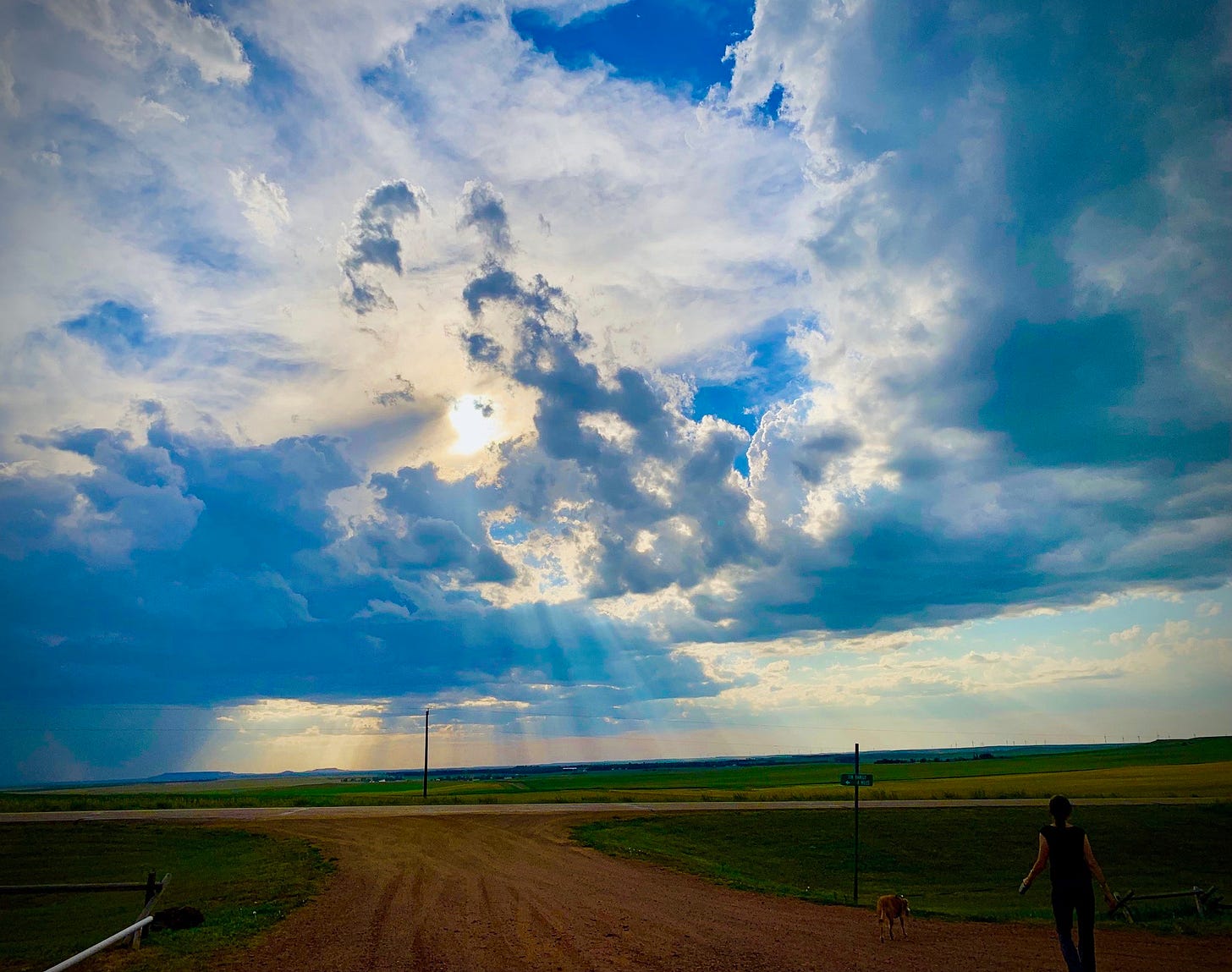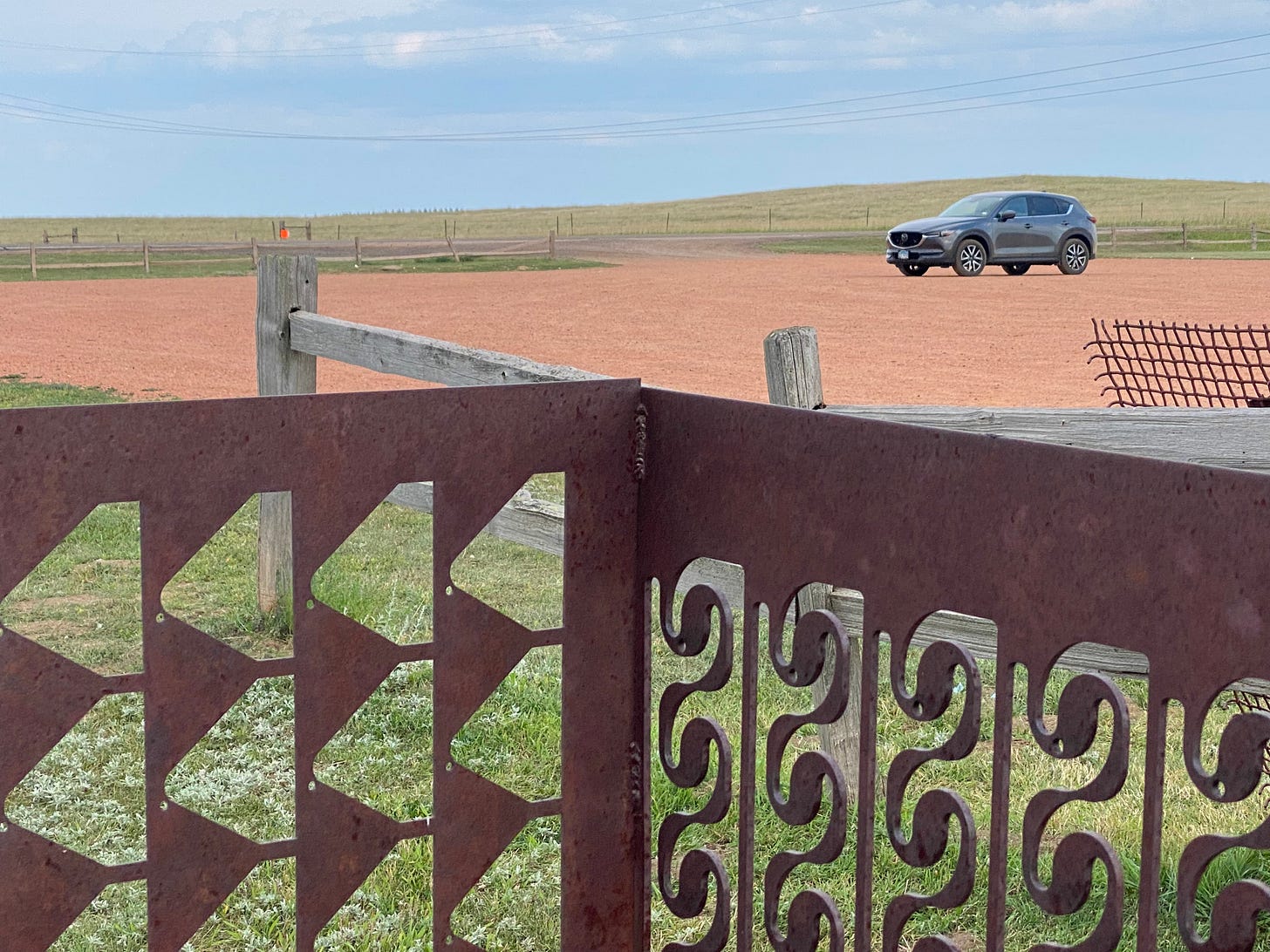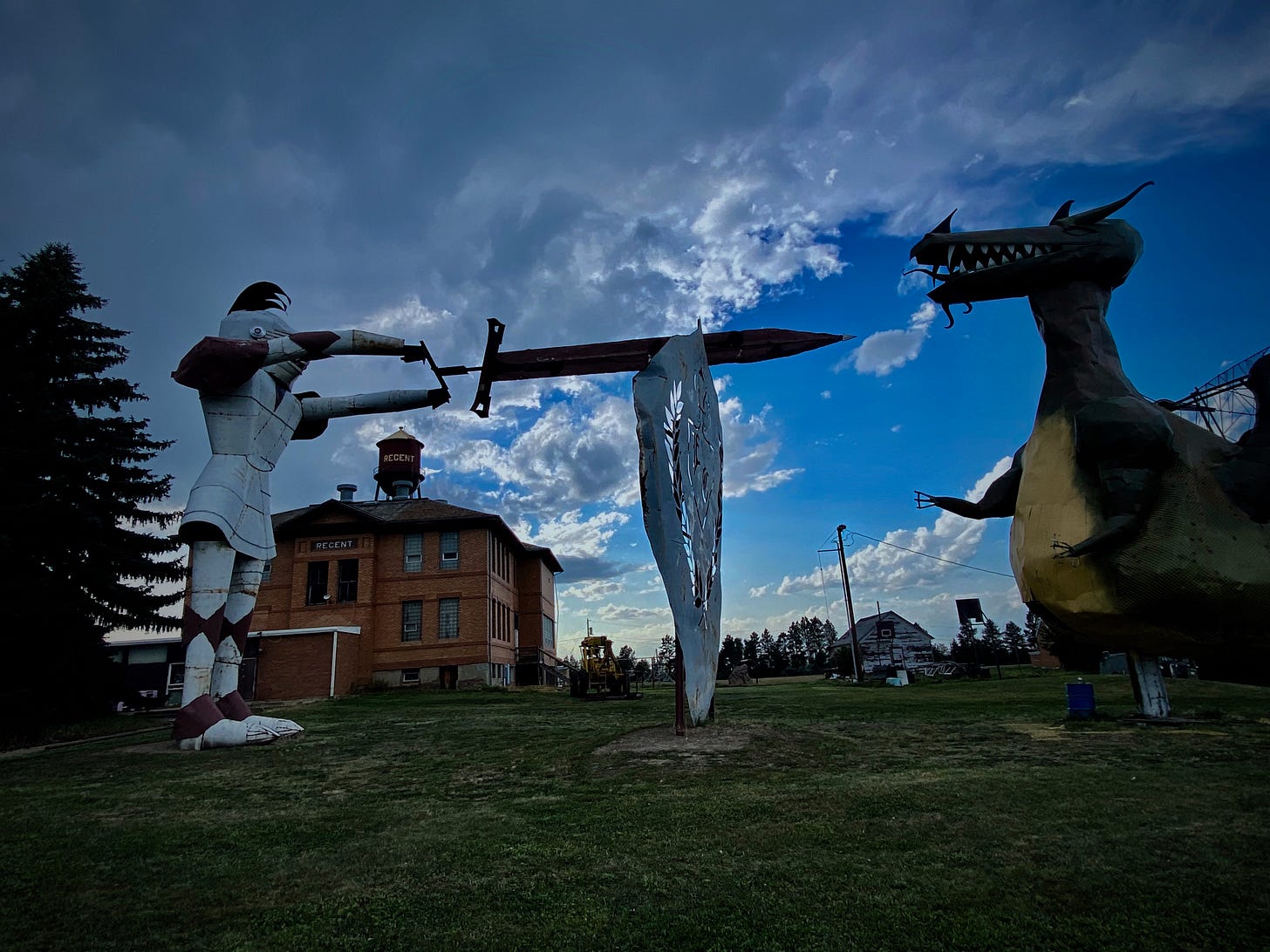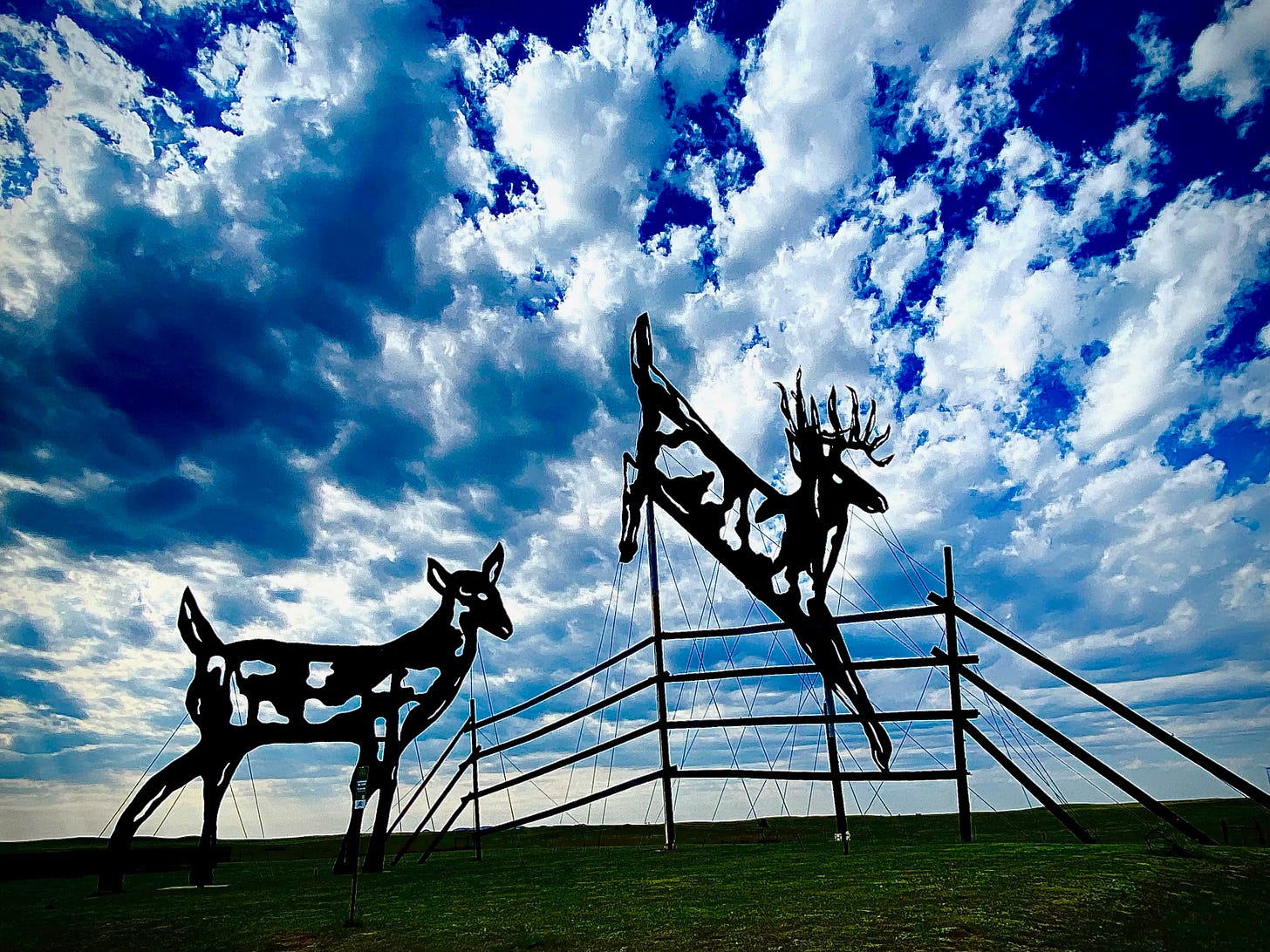
The sky. The sun. The heat. The endless grasslands. The countless grasshoppers! Hundreds, maybe thousands, smashed into our car’s front grille. Our little urban Mazda literally doesn’t know what hit it. I feel the same way. Coming from Chicago, I’d thought that Fargo, North Dakota was an exotically remote destination. Driving due west past Bismarck en route to three national parks (Theodore Roosevelt, Grasslands, and Banff), I’m starting to realize just what a ridiculously naive presumption that was.
The Great Northern Plains is a land of fierce, elemental extremes. Earth, air, fire, water. The land goes on and on. Wheat fields, grasslands, open range. Few trees, little water, no shade. The sky is radically, astonishingly, arrestingly big. Utterly different from the unremarkable city backdrop I’m used to, it feels like another planet. Here in western North Dakota, its elemental vastness makes the human world seem very, very small.
It’s August and during the day when the sun’s high, it’s so hot, it’s assaultive. Normally, I’m not sun sensitive and never wear a sunhat. Here, I don’t want to step out of the car for even a few seconds without one. The temperature’s not that high, but the sun’s heat cuts through the air like fire. As soon as it starts to set, though, everything abruptly and mercifully shifts. Suddenly, it’s balmy and comfortable. A light breeze feels like a caressing embrace.
The setting sun shoots lightbeams through roiling oceans of cumulus clouds. Golden trajectories connect earth and sky. The water’s in the air. The resultant alchemy is mythologically beautiful.
My brain jumps to stock phrases that feel both sincerely true and painfully cliched: It’s a manifestation of God. It’s a message from Heaven. It’s a laugh: Trying to translate this vision into the small container of human words is just so obviously futile. You might as well be a smart ant pontificating about New York City. Sorry, nice try, but you’re just too tiny . . . this is so much bigger than you.
And so for the moment, the standard 21st-century tables are flipped. We’re used to feeling existential angst over humanity’s destructive hit on the natural world — and for the most part, quite rightly so. But out here, the human footprint perceptually shrinks (although of course it’s still there) while that of the elemental environment expands. Feeling connected to what for most of human history must have been a quite ordinary perception of life — that is, a visceral sense that we’re simply small specks of consciousness immersed in a mystery that surrounds and includes us — is grounding, nourishing, exhilarating.
The Enchanted Highway
The Enchanted Highway begins 85 miles due west of Bismarck, North Dakota, just off Interstate 94. As you draw towards Exit 72, you can’t miss “Geese in Flight,” a 154-foot long, 110-foot tall, 78.8-ton sculpture, beautifully crafted out of the most prosaic materials — oil tanks and oil well pipe. In classic North Dakota fashion, the sculptor, Gary Greff, drove tractors over them to flatten them out.
“Geese in Flight” has proudly held the Guinness Book of World Records title as the World’s Largest Scrap Metal Sculpture since 2002. As such, it — along with the seven other enormous sculptures along the 32-mile Enchanted Highway, which extends due south from there — is regularly lumped in with other North Dakotan “roadside attractions,” such as “Sandy, the World’s Largest Sandhill Crane” in Steele; “Tommy, the World’s Largest (snowmobile-riding) Turtle” in Bottineau; and “The World’s Largest Catfish” in Wahpeton.
To some extent, this makes sense. Some of the giant metal sculptures on the Enchanted Highway, such as the “Tin Family” — an enormous Dad, Mom, and kid trio built out of farm tanks, telephone poles, barb wire, and augers — fit neatly into the state’s signature “big weird whimsical local oddity and potential tourist attraction” category. But works such as “Geese in Flight” and “Deer Crossing” (pictured at the top of this post) absolutely transcend it.

Pictures are one thing. But when you’re actually there, taking it in along with the surrounding environment and powerful landscape, there’s just no question about it: This is art. And not only that: It’s stunningly beautiful, perfectly site-appropriate, and completely original art. It’s art of caliber we normally don’t get to see. It’s art that’s worth traveling to the remote reaches of North Dakota to experience. And so, it’s art that definitely doesn’t belong in the plebian category of “roadside attraction.”
Or does it? Perhaps way out here in western North Dakota, such niceties of nomenclature don’t matter. There’s a gestalt in which the sum is greater than the whole of its parts. We’re far away from the presumptions and pretensions of city life. So why not morph seamlessly from transcendent art to roadside attraction? The slippage of such conventionally distinct categories actually makes the experience of the Enchanted Highway even more weirdly unique, slyly thought-provoking, and charmingly magical than it would be otherwise.
In this sweepingly open land where the elemental powers of air, earth, fire, and water appear to dwarf human endeavor, the most arresting sculptures on the Enchanted Highway (“Geese in Flight,” “Deer Crossing,” “Grasshoppers,” “Fisherman’s Dream,” and “Pheasants on the Prairie”) work seamlessly and synergistically with these elemental forces. The effect is astonishing, simultaneously casual and reverential, unassuming and majestic. It feels like an extension and manifestation of the spirit of the land itself — including, but by no means limited to its small number of local inhabitants, most of whom are farmers and ranchers.
As such, it makes complete sense that the teacher-turned-artist/welder/entrepreneur who designed and crafted these sculptures, Gary Greff, hails from — and still lives and works in — the small town of Regent (population 170), which anchors the southern end of the Enchanted Highway. It also makes sense that Greff started the whole project in the hope of bringing tourists, along with a much-needed infusion of cash, to this small farm town which, like most of its kind, has been steadily shrinking and increasingly struggling for decades.
Accordingly, there’s a thoroughly down-to-earth, nuts-and-bolts quality to the Enchanted Highway. At the same time, however, it boldly and unapologetically claims the title of “Enchanted.” On the one hand, it’s a roadside attraction that invites everyone and their dog to jump out of the car, run around, have fun, and make silly faces for the camera. On the other, it’s a world-class exemplar of what art historians often refer to as “vernacular art environments”: That is, a “visionary space” built by a grassroots artist that’s “part architecture, part sculpture, part landscape.”1
The bottom line, however, is that it’s true: Driving the Enchanted Highway, you can experience enchantment easily. The road feels charmed. It doesn’t take itself too seriously. But its beauty is profound. And the enchantment is real.
The Enchanted Castle
In Regent, artist Gary Greff owns, manages, and works at The Enchanted Castle, a former high school that — after his shrinking small town had to abandon it — he repurposed into a hotel, steakhouse, and tavern. The hotel boasts 19 guest rooms, a fitness center, hot tubs, and the school’s original gym and locker rooms. On the front lawn, there’s a 41-foot tall sculpture of a medieval knight battling a 42-foot tall, 100-foot long fire-breathing dragon. This piece is still in progress; Greff works on it when he can muster the time and rustle up some extra money.
My son and I had the opportunity to meet this extraordinary artist/entrepreneur when we stopped at the Enchanted Castle tavern to have a beer. An older gentleman with a friendly, casual, and relaxed yet intense demeanor, Greff radiates a luminous aura/vibe. We chatted briefly before he hustled off to wait a table. This wasn’t what I expected: Why was someone so highly accomplished doing such work? But again, I had to readjust my usual presumptions and stock categories. This is a different world than I’m used to, one where they simply don’t apply.
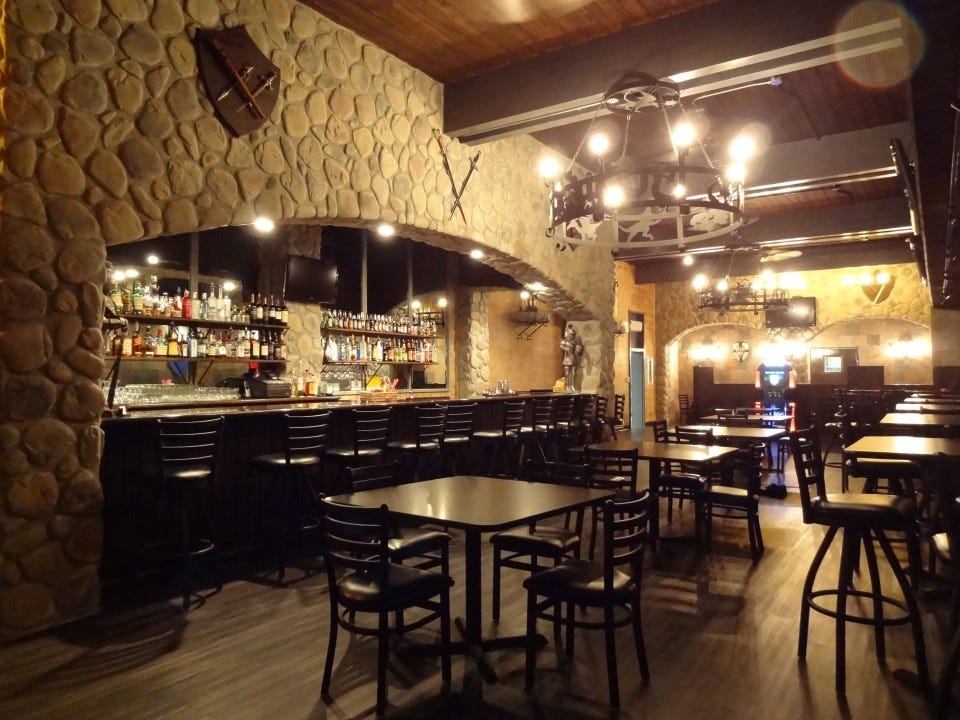
I’d come into the tavern on a high, delighted by the experience of driving the Enchanted Highway on the twilight cusp of a beautiful summer evening. Greff brought me back down to earth again, though, when he off-handedly shared that while he’s eager to finish his current sculpture and start a new one (he wants to extend the reach of the fire on the fire-breathing dragon), the pace of his work is necessarily quite slow due to a shortage of funds. Equally disappointing, many of the more traditionalist-minded townfolk are unsupportive of the entire project, if not hostile. They don’t like having an eclectic set of enormous sculptures in their local community. It’s weird and nothing like the kind of conventional tourist attraction they’d prefer.
Consequently, Greff relies on the modest profit he makes from a tiny gift shop to finance his artwork, along with the goodwill of a small set of local supporters. With no solid source of funding, however, it’s unclear what will happen to The Enchanted Highway once he’s gone. Obviously, the sculptures and grounds surrounding them need upkeep. And in this location, that’s not easy: It’s a harsh, intense climate, with extremely hot summers, cold winters, and fierce storms. The closest town of any size, Bismarck, is almost 90 miles away.
It’s a concerning situation. Someone with some serious money needs to work with Greff to set up a trust or foundation to keep it going. (My hope is that the estimable Kohler Foundation, which is at the forefront of preserving such vernacular art environments both nationally and internationally, may be interested.) In the meantime, however, if you want to support this work, you can plan your visit to The Enchanted Highway or make a donation here.
“Obsessive, ‘weird,’ visionary: vernacular environments are unrestrained testimonials to America’s persistent, enduring, even stoic faith in personal acts and productive realizations of creativity . . . the presence of fantastic outsider art environments . . . is also absolutely central to America’s longstanding inclinations toward cultural democracy, toward a demotic culture situated in the vernacular expression of the nation’s many diverse inhabitants.”
— Erika Doss, “Wandering the Old, Weird America” in Leslie Umberger, Sublime Spaces & Visionary Worlds: Built Environments of Vernacular Artists (Princeton Architectural Press, 2007)




